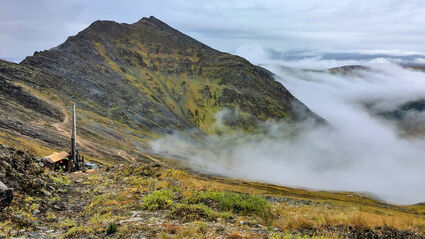Ambler Metals budgets US$22.8M for UKMP
Program is expected to include drilling at Arctic, Sunshine North of 60 Mining News – March 1, 2020
Last updated 9/26/2020 at 12:17pm

Trilogy Metals Inc.
A drill carries out geotechnical testing at Arctic during 2019. This year's program will focus on upgrading additional resources in this VMS deposit to the measured category.
Trilogy Metals Inc. Feb. 26 announced that Ambler Metals LLC, a joint venture operating company equally owned by Trilogy and South32 Ltd., has approved a US$22.8 million budget for the 2020 program aimed at advancing the Upper Kobuk Mineral Projects (UKMP) in Northwestern Alaska.
The largest part of this program will focus on advancing studies to prepare the Arctic mine project for permitting.
A 2018 prefeasibility study for Arctic detailed plans for an open-pit mine and 10,000-metric-ton-per-day mill that is expected to produce more than 159 million pounds of copper, 199 million lb of zinc, 33 million lb of lead, 30,600 ounces of gold and 3.3 million oz of silver annually over a 12-year mine-life.
The mine outlined in the PFS is based on 43.04 million metric tons of probable reserves averaging 2.32% copper, 3.24% zinc, 0.57% lead, 0.49 grams per metric ton gold and 36 g/t silver.
In addition to these reserves, Arctic hosts 36 million metric tons of indicated resource averaging 3.07% copper (2.44 billion lb), 4.28% (3.36 billion lb) zinc, 0.73% (581 million lb) lead, 0.63 g/t (730,000 oz) gold and 47.6 g/t (55 million oz) silver. This volcanogenic massive sulfide deposit also has about 3.5 million metric tons of inferred resource.
The 2020 program at UKMP is slated to include 10,000 meters of drilling at Arctic Project aimed at upgrading inferred and indicated resources to the measured category.
Other work at Arctic this year will include the next phase of metallurgical studies, including pilot plant testing, and geotechnical drilling for infrastructure placement.
The drill program is expected to commence in mid-June and finish at the end of August. Studies are expected to continue throughout the year.
In addition to drilling at Arctic, Ambler Metals will be carrying out a 2,500-meter regional exploration drill program to follow up on the 2019 work performed along the 70-mile (100 kilometer) Ambler VMS belt.
One of the most intriguing targets of the 2019 regional program was Sunshine, a historical VMS deposit about eight miles west of Arctic that hosts 20 million metric tons of resource averaging 1.4% copper, 2.5% zinc, 0.5% lead and 28.1 g/t silver, according to a 1997 calculation by Kennecott Mines.
The six holes drilled at Sunshine last year confirmed the robust nature of this deposit that is similar to Arctic.
One of the best holes drilled last year, SC19-019, cut five metals-rich zones:
• 9.1 meters of 3.02% copper, 1.42% zinc, 0.27 % lead, 0.14 g/t gold and 24.65 g/t silver.
• 3.3 meters of 1.68% copper, 1.77% zinc, 0.47% lead, 0.12 g/t gold and 27.57 g/t silver.
• 3.7 meters of 4.74% copper, 0.97% zinc, 0.13% lead, 0.15 g/t gold and 28.96 g/t silver.
• three meters of 0.75% copper, 1.4% zinc, 0.35% lead, 0.08 g/t gold and 21.02 g/t silver.
• 7.88 meters of 2.23% copper, 5.62% zinc, 1.1% lead, 0.18 g/t gold and 46.95 g/t silver in Zone 4.
Further details of the 2019 drilling at Sunshine can be found at More Sunshine in the Ambler District published in the Nov. 22 edition of North of 60 Mining News.
This year's region drill program is expected to target the Sunshine prospect and at other identified targets across the Ambler Belt. Ahead of the regional drilling, slated to begin in mid-July, Ambler Metals plans to carry out detailed geologic mapping, geochemical soil sampling, and ground geophysics.
Following up on the roughly US$30 million of South32-funded drilling carried out over the previous three field seasons, this year's focus at the Bornite copper-cobalt project will be geological mapping and geochemical soil sampling over the northern Cosmos Hills and review of drill core and surface exposures to determine controls on high grade zones of copper mineralization.
Bornite, located about 16 miles southwest of Arctic, is expected to be the second mine project in the pipeline for Ambler Metals.

Shane Lasley
A rainbow arcs over Bornite, a large copper-cobalt deposit on Ambler Metals' Upper Kobuk Mineral projects in Alaska.
At a cut-off grade of 0.5%, the open-pit portion of Bornite hosts 40.5 million metric tons of inferred resource averaging 1.02% (913 million pounds) copper; and 84.1 million metric tons of indicated resource averaging 0.95% (1.77 billion lb) copper.
At the same cut-off grade, the Bornite open-pit also hosts 124.6 million metric tons of inferred resource averaging 0.017% (45 million lb) cobalt.
The below-pit portion of Bornite, at a cut-off grade of 1.5%, hosts 57.8 million metric tons of inferred resource averaging 2.89% (3.68 billion lb) copper and 0.025% (32 million lb) cobalt.
Cosmos Hills is a prospective area west of Bornite.
Although there is no planned drilling at the Bornite Project in 2020, the Bornite geological database will be updated and the Ambler Metals team will identify priority drill targets for the 2021 field season.
















Reader Comments(0)